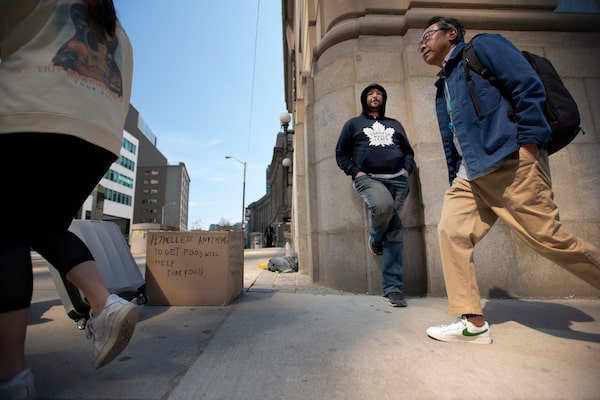
Toronto's roughly 9,000-bed shelter system is chronically full, with an average of roughly 120 people turned away each night in March, according to city data.Fred Lum/The Globe and Mail
Toronto has declared a state of emergency on homelessness, joining Hamilton, Ottawa and the Niagara Region in sounding the alarm on crisis levels of poverty in major Ontario cities.
The motion – which also included prioritizing the opening and operation of 24-hour respite (or drop-in) sites – passed almost unanimously without debate at Toronto City Hall on Friday, with only Etobicoke Centre Councillor Stephen Holyday voting against it.
Though largely symbolic, the declaration is intended to spur support – and funding – from other levels of government in the face of a growing housing affordability crisis.
There are more than 80,000 households on Toronto’s waitlist for social housing, as rental rates continue to spiral out of reach for anyone on a fixed income. The city’s roughly 9,000-bed shelter system is chronically full, with roughly 120 people turned away on average each night in March, according to the most recent city data. More than 170 encampments remain across various city parks, alleys, sidewalks and underpasses.
Toronto Public Health data shows that at least 187 people experiencing homelessness died in the city in 2022. More than 220 died while homeless in 2021.
“Front-line workers and homeless people have been calling this an emergency for decades,” said Cathy Crowe, a long-time street nurse in the city, on Friday.
She was there in 1998 when city council declared homelessness a “man-made disaster,” and said she is proud that Toronto is finally acknowledging the emergency again.
“Now they have to carry it – now they have to do something with that message,” she said. “There should be a massive wartime effort to be moving people into housing.”
Scarborough Councillor Paul Ainslie, who introduced the motion at last month’s Economic and Community Development Committee, says the city needs an additional $20-million for the Canada-Ontario Housing Benefit program – which is a subsidized rent benefit for priority groups in need of housing – as well as an additional $5-million for warming centres. That funding is critical, he says – and there’s no Plan B.
“I said to staff: ‘So, if you don’t get that money, what do we do?’ ” Mr. Ainslie said in a phone interview. “There was a lot of shrugging.”
Politicians in Hamilton, Niagara and Ottawa have similarly been calling on other levels of government for support.
Hamilton City Council unanimously voted to declare a state of emergency on homelessness, mental health and opioid addiction in April, and the Niagara Region did so in March. Ottawa did the same prior to the pandemic, in January, 2020.
“As more municipalities ring the alarm bells, the message we’re collectively sending to the province and the federal government is clear, we cannot solve these crises alone,” said Andrea Horwath, the mayor of Hamilton and former leader of the Ontario NDP, in an e-mail.
But as they look to the province and federal governments, anti-poverty advocates argue cities too must exhaust all avenues of support.
Tim Richter, chief executive officer of the Canadian Alliance to End Homelessness, says the way a city responds to the crisis is directly analogous to how they’d handle a natural disaster. If 10,000 people were suddenly made homeless by a fire or flood, there would be an immediate and co-ordinated response, he said.
“If you’re going to declare a disaster, treat it like one,” he said. “It’s not just senior governments that need to act differently. There’s an awful lot that Toronto can do.”
 Molly Hayes
Molly Hayes